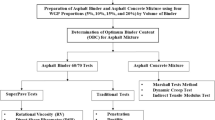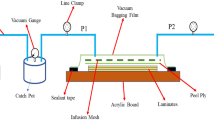Abstract
The present investigation mainly aimed at analyzing the rutting responses of polymer-modified binders with and without Polyphosphoric Acid (PPA) and by considering increased loading times in the Multiple Stress Creep and Recovery (MSCR) tests. Typical high pavement temperatures of 52, 58 and 64 °C were chosen, and these loading times varied from 1.0 to 8.0 s (1/9, 2/9, 4/9 and 8/9 s). Formulations with styrene–butadiene–styrene copolymer—SBS (AC + SBS and AC + SBS + PPA), ethylene vinyl acetate copolymer—EVA (AC + EVA and AC + EVA + PPA) and Elvaloy® terpolymer (AC + Elvaloy + PPA) were prepared, and the high PG grade of all these formulations was controlled at 76-XX. In general, the AC + Elvaloy + PPA was the best formulation to counteract rutting at longer creep times—especially 4/9 and 8/9 s—due to the presence of a strong and stable polymer network within the binder matrix. Moreover, the AC + SBS + PPA was able to deal with traffic levels similar or slightly higher than those of the AC + SBS, and this might be attributed to the hardness imparted by PPA modification and the presence of more stable polymer networks in the AC + SBS + PPA. On the other hand, the AC + EVA + PPA was found to be less rut resistant than the AC + EVA, and none of the EVA-modified binders depicted sufficient degrees of stiffness to deal with heavier and slow-moving traffic levels—mainly for temperatures of 58 °C or higher and loading times of 4/9 s or longer. Overall, the data indicate that binders with high degrees of stiffness at standardized MSCR loading conditions (1/9 s) do not necessarily perform well at longer creep times.




Similar content being viewed by others
References
Read, J., & Whiteoak, D. (2003). The Shell Bitumen Handbook (5th ed.). Thomas Telford Publishing.
Yildirim, Y. (2007). Polymer modified asphalt binders. Construction & Building Materials, 21(1), 66–72.
Isacsson, U., & Lu, X. (1995). Testing and appraisal of polymer modified road bitumens–state of the art. Materials & Structures, 28, 139–159.
Imaninasab, R. (2016). Rutting resistance and resilient modulus evaluation of polymer-modified SMA mixtures. Petroleum Science & Technology, 34(16), 1483–1489.
White, G. (2017). Grading highly modified binders by multiple stress creep recovery. Road Materials & Pavement Design, 18(6), 1322–1337.
Polacco, G., Stastna, J., Biondi, D., & Zanzotto, L. (2006). Relation between polymer architecture and nonlinear viscoelastic behavior of modified asphalts. Current Opinion in Colloid & Interface Science, 11(4), 230–245.
Fernandes, M. R. S., Forte, M. M. C., & Leite, L. F. M. (2008). Rheological evaluation of polymer-modified asphalt binders. Materials Research, 11(3), 381–386.
Orange, G., Martin, J.-V., Menapace, A., Hemsley, M., & Baumgardner, G. L. (2004). Rutting and moisture resistance of asphalt mixtures containing polymer and polyphosphoric acid modified bitumen. Road Materials & Pavement Design, 5(3), 323–354.
D’Angelo, J., & Dongré, R. (2009). Practical use of multiple stress creep and recovery test: Characterization of styrene-butadiene-styrene dispersion and other additives in polymer-modified asphalt binders. Transportation Research Record, 2126, 73–82.
Polacco, G., Filippi, S., Merusi, F., & Stastna, J. (2015). A review of the fundamentals of polymer-modified asphalts: Asphalt/polymer interactions and principles of compatibility. Advances in Colloid & Interface Science, 224, 72–112.
Saboo, N., & Kumar, P. (2016). Analysis of different test methods for quantifying rutting susceptibility of asphalt binders. Journal of Materials in Civil Engineering, 28(7), 04016024.
Saboo, N., & Kumar, P. (2015). A study on creep and recovery behavior of asphalt binders. Construction & Building Materials, 96, 632–640.
Radhakrishnan, V., Sri, M. R., & Reddy, K. S. (2018). Evaluation of asphalt binder rutting parameters. Construction & Building Materials, 173, 298–307.
Domingos, M. D. I., Faxina, A. L., & Bernucci, L. L. B. (2019). Rutting behavior and rheological modeling of EVA-modified binders in the mixture and binder scales. Materials & Structures, 52, 36.
Fee, D., Maldonado, R., Reinke, G., & Romagosa, H. (2010). Polyphosphoric acid modification of asphalt. Transportation Research Record, 2179, 49–57.
Hafeez, I., Mian, I., Zaidi, B., Kamal, M. A., Ahmed, N., Ullah, S., Hussain, J., Riaz, K., & Hussain, S. (2013). To study the viscoelastic behavior of asphalt binders using under multi stress creep recovery test. Life Science Journal, 10(12s), 921–925.
Bessa, I. S., Takahashi, M. M., Vasconcelos, K. L., & Bernucci, L. L. B. (2019). Characterization of neat and modified asphalt binders and mixtures in relation to permanent deformation. Science & Engineering of Composite Materials, 26(1), 379–387.
Delgadillo, R., Bahia, H. U., & Lakes, R. (2012). A nonlinear constitutive relationship for asphalt binders. Materials & Structures, 45(3), 457–473.
Kodrat, I., Sohn, D., & Hesp, S. A. M. (1998). Comparison of polyphosphoric acid-modified asphalt binders with straight and polymer-modified materials. Transportation Research Record, 2007, 47–55.
Domingos, M. D. I., & Faxina, A. L. (2016). Susceptibility of asphalt binders to rutting: Literature review. Journal of Materials in Civil Engineering, 28(2), 04015134.
Ishaq, M. A., Venturini, L., & Giustozzi, F. (2021). Correlation between rheological rutting tests on bitumen and asphalt mix flow number. International Journal of Pavement Research & Technology. https://doi.org/10.1007/s42947-021-00089-z
Salim, R., Gundla, A., Zalghout, A., Underwood, B. S., & Kaloush, K. E. (2019). Relationship between asphalt binder parameters and asphalt mixture rutting. Transportation Research Record, 2673(6), 431–446.
American Society for Testing and Materials, Standard Test Method for Multiple Stress Creep and Recovery (MSCR) of Asphalt Binder Using a Dynamic Shear Rheometer. D7405-15. ASTM, West Conshohocken, PA, 2015
American Association of State Highway and Transportation Officials, Standard Method of Test for Multiple Stress Creep Recovery (MSCR) Test of Asphalt Binder Using a Dynamic Shear Rheometer (DSR). T 350-19. AASHTO, Washington, DC, 2019
Stempihar, J., Gundla, A., & Underwood, B. S. (2018). Interpreting stress sensitivity in the multiple stress creep and recovery test. Journal of Materials in Civil Engineering, 30(2), 04017283.
Pereira, P. A. A., Pais, J. C., & Sousa, J. B. (2000). Modelling the effect of truck speed on permanent deformation of asphalt mixes. Road Materials & Pavement Design, 1, 197–207.
American Association of State Highway and Transportation Officials, Standard Specification for Performance-Graded Asphalt Binder Using Multiple Stress Creep Recovery (MSCR) Test. M 332-14. AASHTO, Washington, DC, 2014
Salim, R., Gundla, A., Underwood, B. S., & Kaloush, K. E. (2019). Effect of MSCR percent recovery on performance of polymer modified asphalt mixtures. Transportation Research Record, 2673(5), 308–319.
Golalipour, A., Bahia, H. U., & Tabatabaee, H. A. (2017). Critical considerations toward better implementation of the multiple stress creep and recovery test. Journal of Materials in Civil Engineering, 29(5), 04016295.
American Association of State Highway and Transportation Officials, Standard Specification for Performance-Graded Asphalt Binder. M 320-09. AASHTO, Washington DC, USA, 2009
American Society for Testing and Materials, Standard Test Method for Determining the Rheological Properties of Asphalt Binder Using a Dynamic Shear Rheometer. D7175-08. ASTM, West Conshohocken PA, USA, 2008
American Society for Testing and Materials, Standard Test Method for Viscosity Determination of Asphalt at Elevated Temperatures Using a Rotational Viscometer. D4402-12. ASTM, West Conshohocken PA, USA, 2012
Kodrat, I., Sohn, D., & Hesp, S. A. M. (1998). Comparison of polyphosphoric acid–modified asphalt binders with straight and polymer-modified materials. Transportation Research Record, 2007, 47–55.
American Society for Testing and Materials, Standard Test Method for Effect of Heat and Air on a Moving Film of Asphalt (Rolling Thin-Film Oven Test). D2872-12. ASTM, West Conshohocken PA, USA, 2012
Mallick, R. B., & El-Korchi, T. (2013). Pavement engineering: Principles and practice (2nd ed.). CRC Press.
C. Faccin, S. L. Schuster, P. O. B. Almeida Junior, P. M. Vestena, L. P. Specht, L. D. Bueno, L. F. M. Leite (35° Congresso de Pesquisa e Ensino em Transportes [in Portuguese], 2021), https://www.anpet.org.br/anais35/documentos/2021/Infraestrutura/Ligantes%20e%20Misturas%20Asf%C3%A1lticas/5_58_AC.pdf. Accessed 17 Mar 2022
Shenoy, A. (2004). A comprehensive treatise of the high temperature specification parameter |G*|/(1-(1/tanδsinδ)) for performance grading of asphalts. Applied Rheology, 14(6), 303–314.
Domingos, M. D. I., & Faxina, A. L. (2019). Alternative interpretation of the adequate traffic levels of modified bitumens on Superpave®: a case study with crumb rubber and polyphosphoric acid (PPA). Road Materials & Pavement Design, 20(Supl.2), S632–S646.
M. Anderson (54th Annual Idaho Asphalt Conference, 2014). http://web.archive.org/web/20190430182245/https://www.webpages.uidaho.edu/bayomy/IAC/54th/Presentations_54th/2.%20IAC2014_MSCR_Mike%20Anderson.pdf. Accessed 17 Mar 2022
Liu, Y., & You, Z. (2009). Determining burger’s model parameters of asphalt materials using creep-recovery testing data. In Z. You, A. R. Abbas, & L. Wang (Eds.), Pavements and materials: modeling, testing, and performance (pp. 26–36). American Society of Civil Engineers.
Goli, A., Baditha, A., Muppireddy, A. R., & Pandey, B. B. (2019). Comparison of various rutting parameters and modelling of creep and recovery behaviour of high modulus bituminous binders. International Journal of Pavement Research & Technology, 12, 648–658. https://doi.org/10.1007/s42947-019-0077-1
Merusi, F. (2012). Delayed mechanical response in modified asphalt binders characteristics, modeling and engineering implications. Road Materials & Pavement Design, 13(Supl.1), 321–345.
Roberts, F. L., Kandhal, P. S., Brown, E. R., Lee, D.-Y., & Kennedy, T. W. (1996). Hot mix asphalt materials, mixture design and construction (2nd ed.). Lanham: NAPA Education Foundation.
Sybilski, D. (1996). Evaluation of validity of conventional test methods in case of polymer bitumens. Preprints of Papers, American Chemical Society, Division of Fuel Chemistry, 41(4), 1302–1306.
Nejad, F. M., Gholami, M., Naderi, K., & Rahi, M. (2015). Evaluation of rutting properties of high density polyethylene modified binders. Materials & Structures, 48, 3295–3305.
Marasteanu, M. O., Clyne, T., McGraw, J., Li, X., & Velazquez, R. (1901). High-temperature rheological properties of asphalt binders. Transportation Research Record, 2005, 52–59.
DuBois, E., Mehta, Y., & Nolan, A. (2014). Correlation between multiple stress creep recovery (MSCR) results and polymer modification of binder. Construction & Building Materials, 65, 184–190.
S. Rani, R. Ghabchi, M. Zaman, S.A. Ali, Effect of polyphosphoric acid on stress sensitivity of polymer-modified and unmodified asphalt binders, in airfield and highway pavements 2019: Testing and characterization of pavement materials, ed. by: I. Al-Qadi, H. Ozer, A. Loizos, S. Murrell (American Society of Civil Engineers, Reston, 2019), p. 238–247
Wang, H., Liu, X., Zhang, H., Apostolidis, P., Scarpas, T., & Erkens, S. (2020). Asphalt-rubber interaction and performance evaluation of rubberised asphalt binders containing non-foaming warm-mix additives. Road Materials & Pavement Design, 21(6), 1612–1633.
Bulatović, V. O., Rek, V., & Marković, J. (2014). Rheological properties of bitumen modified with ethylene butylacrylate glycidylmethacrylate. Polymer Engineering & Science, 54(5), 1056–1065.
Arshadi, A. (2013). Importance of asphalt binder properties on rut resistance of asphalt mixture. MSc: Thesis University of Wisconsin-Madison.
Divya, P. S., Gideon, C. S., & Krishnan, J. M. (2013). Influence of the type of binder and crumb rubber on the creep and recovery of crumb rubber modified bitumen. Journal of Materials in Civil Engineering, 25(4), 438–449.
Li, X., Clyne, T., Reinke, G., Johnson, E. N., Gibson, N., & Kutay, M. E. (2011). Laboratory evaluation of asphalt binders and mixtures containing polyphosphoric acid. Transportation Research Record, 2210, 47–56.
D’Angelo, J. (2010). New high-temperature binder specification using multistress creep and recovery. Transportation Research Circular, E-C147, 1–13.
Qi, X., & Witczak, M. W. (1998). Time-dependent permanent deformation models for asphaltic mixtures. Transportation Research Record, 1639, 83–93.
Golalipour, A. (2011). Modification of multiple stress creep and recovery test procedure and usage in specification. Thesis University of Wisconsin-Madison.
Acknowledgements
Grants 2013/20483-6 and 2006/55835-6, São Paulo Research Foundation (FAPESP).
Funding
São Paulo Research Foundation (FAPESP).
Author information
Authors and Affiliations
Corresponding author
Ethics declarations
Conflict of interest
The authors declare that they have no conflict of interest.
Rights and permissions
Springer Nature or its licensor holds exclusive rights to this article under a publishing agreement with the author(s) or other rightsholder(s); author self-archiving of the accepted manuscript version of this article is solely governed by the terms of such publishing agreement and applicable law.
About this article
Cite this article
Inocente Domingos, M.D., Faxina, A.L. The Importance of Lower Truck Speeds (Longer Creep Times) on the Rutting Responses of Polymer-Modified Asphalt Binders. Int. J. Pavement Res. Technol. 17, 379–396 (2024). https://doi.org/10.1007/s42947-022-00242-2
Received:
Revised:
Accepted:
Published:
Issue Date:
DOI: https://doi.org/10.1007/s42947-022-00242-2




